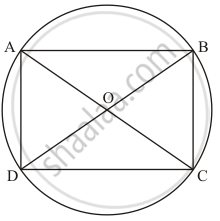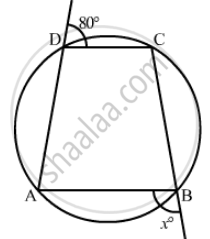Advertisements
Advertisements
प्रश्न
Prove that the centre of the circle circumscribing the cyclic rectangle ABCD is the point of intersection of its diagonals.
उत्तर
Here, ABCD is a cyclic rectangle; we have to prove that the centre of the corresponding circle is the intersection of its diagonals.

Let O be the centre of the circle.
We know that the angle formed in the semicircle is 90°.
Since, ABCD is a rectangle, So
`angleADC = angleDCB = angleABC = angleBAD = 90°`
Therefore, AC and BD are diameter of the circle.
We also know that the intersection of any two diameter is the centre of the circle.
Hence, the centre of the circle circumscribing the cyclic rectangle ABCD is the point of intersection of its diagonals.
APPEARS IN
संबंधित प्रश्न
ABC and ADC are two right triangles with common hypotenuse AC. Prove that ∠CAD = ∠CBD.
AC and BD are chords of a circle which bisect each other. Prove that (i) AC and BD are diameters; (ii) ABCD is a rectangle.
Two congruent circles intersect each other at points A and B. Through A any line segment PAQ is drawn so that P, Q lie on the two circles. Prove that BP = BQ.
The lengths of two parallel chords of a circle are 6 cm and 8 cm. If the smaller chord is at distance 4 cm from the centre, what is the distance of the other chord from the centre?
Bisectors of angles A, B and C of a triangle ABC intersect its circumcircle at D, E and F respectively. Prove that the angles of the triangle DEF are `90^@-1/2A, 90^@-1/2B" and "90^@-1/2C`
In the given figure, ABCD is a cyclic quadrilateral. Find the value of x.

ABCD is a cyclic quadrilateral in which BA and CD when produced meet in E and EA = ED. Prove that EB = EC.
In the figure, ▢ABCD is a cyclic quadrilateral. If m(arc ABC) = 230°, then find ∠ABC, ∠CDA, ∠CBE.

If non-parallel sides of a trapezium are equal, prove that it is cyclic.
If bisectors of opposite angles of a cyclic quadrilateral ABCD intersect the circle, circumscribing it at the points P and Q, prove that PQ is a diameter of the circle.
